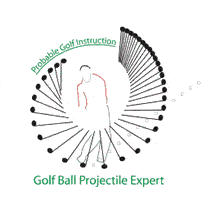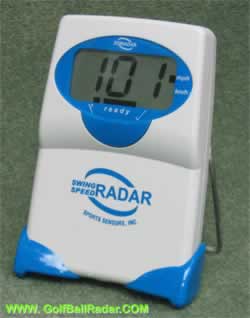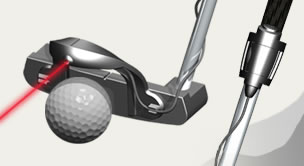
|
|
|
Golf Playing LessonsFrom this page, you can access playing lessons for various parts of the game. Click on the topics below and you'll be taken to the appropriate place in the website. Look below the navigation menu (the one below this sentence) for the specific page's content.
The Last 3 Holes -- StrategyClick here to order Dave's Pelz's Short Game Bible, OR get it at your local bookstore. BUT, whatever you do, GET IT !! Your game will love you for it. Recap from Last Time † My statistical analysis of 1700 amateur scores found that 90% of players that play over NET PAR on the first three holes also shot over NET PAR for the total score. 82% of those that scored on the first 3 holes with a pace of NET 75 or worse, shot a total score of over NET 75 (assuming a 72 par). The first 3 holes of a round have a strong influence over the play for the rest of the round. As I've said many times, play conservatively on the first 3 holes to avoid disasters that will throw your confidence into a spiral. Holes 7 and 8 Hole #7 is a 180 yard PAR 3 from the regular men's tees. The tee is elevated about 13 yards above the green. How do I know this? I measured the angle of declination with my digital inclinometer and the distance with my Bushnell Rangefinder. This will make the hole play about 165 yards, due to the elevation change . The wind has come up and is blowing across the hole from right to left. The tee is in a chute of trees so it's difficult to measure accurately the speed of the wind by throwing up grass clippings. Thus, it's more of a guessing game trying to judge the wind's effect. The pin is on the right hand side and back. The green is guarded front left by a bunker. Trying to get the ball close is quite risky. To do so, I'd have to aim right of the green. If I misjudge the wind, it might not steer my ball far enough left, and I might miss the green to the right. Plus, the wind might take a little distance off my shot and I might land in the bunker. So, I aim right at the bunker. I make pretty good contact and pull the shot a little, The wind carries it further left but I catch the left hand portion of the green. Unfortuately, I'm left with a 60 foot uphill putt. But, that's better than being in the bunker or right of the green with a difficult downhill flop shot. The green slopes right to left. On a long putt, my main focus is on trying to get the ball within a 6 foot radius circle about the hole. Because it's an uphill putt, I'll probably leave it short, which is fine as I'll be left with an uphill putt. The putt is relatively straight except that there is a little ridge half way to the hole that will deflect the ball right. Because the ball will be moving quite fast at the ridge, the deflection will be small. I aim about a foot left of the hole and knock the ball just 2 feet shot leaving a simple uphill putt. I make my par and fee quite relieved. Hole #8 is a 485 yard PAR 5 that doglegs sharply left. Today, it's dead into the wind. I drop a few grass clippings and measure the wind speed to be about 4.5 mph. The speed of the wind is higher up above the ground where the ball will fly so it'll play more like a 7 mph wind. A head wind will cause the ball to balloon higher into the air. It's best to hit a lower shot. If there were no wind, I'd hit my trusty 2-wood and draw the ball around the dogleg. My 2-wood hits the ball too high to play into the wind. So, I'm not going to be hitting the green in two today. I choke down on my Driver for more control and hit a soft fade to the right side of the fairway. I'm left wth 240 yards to the green, which is elevated above the fairway by about 15 yards. I'd like to leave myself about 80 yards as this will result in a flat lie (anything shorter will be an uphill lie). So, I need to hit my second 160 yards, but uphill. The shot will play more like about 170 yards due to the uphill but there's also the wind, which I figure will add another 8 yards to the shot, so 178 yard total. For me, a good 5-iron. I choose to choke down a little on a 4-iron to ensure I get up on to the plateau. I hit the 4-iron a little thin. I'm left wtih 90 yards and a little bit of an uphill lie. The pin is in the middle of the green, wind still blowing. On a flat lie shot, I'd hit a choke down (1 inch) wedge. Since there's an uphill lie, I take the 9-iron and choke down by 1.5 inches (the 9-iron is a half inch longer than the wedge). So, I'm playing the same length club with less loft. The uphill lie will increase the trajectory of the shot.Choking down also gives me more control. I hit a solid shot and am left with a 10 footer that is slightly downhill and breaks right to left. I use my plumb bob technique and determine that the putt will break about 5 inches. In surveying around the hole, it doesn't look to break that much (from my experience). I plumb again and get the same result. Doubt is the worst thing to have in your mind when playing a shot, especially a putt. I need to make a final decision, believe it is the best guess, and go with it. Even when I stand over the ball, the break seems very slight. I must just focus on aiming 5 inches to the right, trusting my read and my stroke. If I doubt, 9 times out of 10, I'll execute a poor stroke. I put a good stroke on the ball, but give it a little too much speed. The putt rolls over the right lip. But, again, I feel confident and in control because a believed in my read and executed well. Hole 9 Hole #9 is a 385 yard, dogleg right, PAR 4 from the regular men's tees. Most of the doglegs on this course are to the left, favouring a draw for a right handed swinger. So, the 9th hole can favour a fade or slice player except that the right hand side is guarded by a large bunker. If I hit the ball a little left off the tee and hit it too far, I can go through the fairway into the trees. Club selection is very important off the tee. If the wind is with me, I'll usually hit a 2-iron. If hit well, it'll go far enough to get down to the bottom of a depression in the fairway. The wind today is into my face so a 2-iron will leave me a long 2nd shot. I tend to pull or pull draw my 2-wood when not swinging well. My Driver, on the other hand, will tend to be straighter. I find that I can hardly put a draw on the ball with my Driver (a Ping TSI) due to the large club face. I choke up on the grip about and inch or two for more control aiming at the center of the fairway. If I do fade the ball a bit, it will carry far enough to clear the bunker. I think I've mentioned before that the most crucial part of the swing is at the top of the backswing. Most of us tend to be far too quick here when not swinging well. When I'm concerned about my ball striking, I'll tend to consciously try to be slower in this region of the swing, trying to have a slight pause at the top of the backswing. Unfortunately, I didn't think of this on this occasion and because I was a little anxious given that last hole and wanting a good score, I got a little quick and came over the top, and pulled my tee shot into the trees on the left. I find my ball and have a clear swing. Unfortunately, I don't have a direct line to the green. I'd have to hook the ball to get it on the green. The pin is on the right front portion of the green. If I miss the shot to the left (likely if I don't pull off the hook), I'll have a next to impossible up and down. The smart shot is to chip the ball out of the trees to a position where I have a flat lie. Then, I'll have a chance of saving par, but, know that I'll likely make a bogie. I've pulled off the hook shot before but know that the odds are more against me today because my ball striking is not that good. Finishing 2 over par would not be that bad. I could still have a decent back nine and break 75 which is what I'm always happy with if not hitting the ball well. I chip the ball out using a 5-iron so that the ball goes low enough to hit into an uphill slope and end up at about the 80 yard range. On such a shot, I focus on just making a half swing, playing the ball back futher in my stance than normal to insure not hitting the shot fat. I also focus on the ball a little more to avoid "looking up" and topping the shot. I even will practice hitting half 5-irons on the range. I hit the shot a little thin, and end up 90 yards from the green but with a flat lie. The green has two tiers; the transition between the two occurs midway. Since the pin is on the front of this 40 yard long green, I'm only about 80 yards from the pin, my favourite distance with the wedge. I hit my 50 degree wedge 70 yards when I choke down fully on the grip. If I move my hands up on the grip one inch (so there is an inch of grip showing below my right hand), I hit the wedge 80 yards with a full swing. I'm playing a Titleist Pro V1, which maximizes the spin I can get on the ball. There is a bunker guarding the front, left of the green. So, I aim about 5 yards to the left of the pin and hit a solid shot. I end up with a 25 foot putt, short and left of the hole. I use my plumb bob technique and determine that the putt will break about 4 inches to the right.My focus on such a a putt is purely speed. Once I've read the putt, I must commit to the line and just try to make a smooth, solid stroke. I take two practice strokes to get a feel for the distance. I put a good stroke on the ball and hit the ball solidly. The ball starts out on the correct line but falls 6 inches short. My read was right on. Have you ever noticed how when you're putting well, you hit the ball very solidly time after time. It's the same as ball striking with the long game. If I'm not putting the ball solidly, I try to focus more on keeping still over the ball and not looking up to see where the ball has gone until I've noticed the ball has disappeared. Most mishit putts or a result of trying to "take a peek" too early. I'll also focus on a slow transition between the back stroke and forward stroke, just like I do with the full swing
If you have any questions or comments, feel free to email me at golfexpert@probablegolfinstruction.com ©Probable Golf Instruction, Ken Tannar 2001-2011. All Rights Reserved. Langley, B.C. V2Y 2G4Phone: 604-539-7760 FAX: to fax, email an attachment probablegolf@yahoo.ca or golfexpert@probablegolfinstruction.com |
| GOLF SOFTWARE |
|
Power Meter measures Swing Speed
|
| GOLF NEWS |
|
| GOLF NEWSLETTER |
Statistics
·Putting
·Long Balls
·Games
·Handicap
·Scoring
·Shot Patterns
·Tournaments
·Tours
Pro Shop
·Ball Marker Engraved
·Books
·CDs & DVDs
·Green Reader
·Impact Labels
·Laser Rangefinder
·Longer Drives
·Products
·Teaching Aids
|
Subscribe to the Probable Golf Newsletter
and
|
| GOLF POLL |
The 19th Hole
·Advertising
·Ask the Golf Expert
·Consultation/Litigation
·FAQs
·Golf Blog
·Golf Draws
·Links
·Science of Golf
·Tell a Friend
·Testimonials
·

Golf Ball Finder Glasses
·
| GOLF CARTOON |






